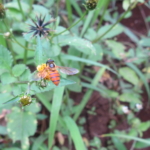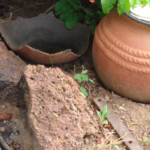


University of Greenwich
Lilongwe University of Agriculture and Natural Resources, The Nelson Mandela African Institution of Science, and Technology, Royal Botanic Gardens - Kew
Uganda
8/2013—8/2017
The majority of smallholders in southern Africa produce legumes in what are by default organic systems, with many not undertaking any field practices to control endemic insect pests of their crops. However to realize the genetic potential of the improved varieties that are being increasingly promoted and make large advances over the typical yields of 400kg ha-1 under farmer management, requires attention to insect damage. Since 2009, CCRP has supported research to investigate the potential for developing the use of botanical insecticides, generally water extracts of locally available plants that are known to have pesticidal properties. Over the last four years the project has demonstrated the efficacy of the pesticidal plant, Tephrosia vogelii, as well as the parameters (chemotype, seasonality, extraction process) that effect variability of efficacy against pests of legumes and other crop pests. A four year extension to this work with a re-configured team of southern Africa institutes led by University of Greenwich and Royal Botanic Gardens Kew in UK will develop knowledge for farmers to use botanicals in legume crops. Research will also focus on improving product quality and safety by reducing consumer exposure to pesticidal plants and overcoming regulatory hurdles by working with businesses and government to develop value chains which can simultaneously improve supply and demand for pesticidal plant products and contribute to sustainable programes of agroecological intensification and rational integrated pest management for legume crops.
Increase data on pre- and post-harvest efficacy of pesticidal plants under African farm conditions.Develop novel ways of helping farmers assess potential efficacy of collected pesticidal plantsDevelop novel ways of reducing potential consumer exposure to pesticidal plants to increase safe useChampion stakeholder development for pesticidal plant value chains
Recognizing that farmers do not have access to solvents commonly used in laboratories, a field trial was conducted to research the parameter of adding soap during or after extraction of plants in water. The objective was to investigate whether soap would help extract the relatively more hydrophobic bioactive compounds known to be present in several plant species, thereby optimizing extraction efficacy in water and improving results for farmers applying extracts on their field crops. The research showed that adding soap during extraction significantly improved overall efficacy in comparison to adding soap after extraction but before application. The trial also showed that the plants were as equally good as the commercial synthetic with similar yields of beans obtained. With respect to ecosystem services and developing principles of agro-ecological intensification, the pesticidal plant treatments did not appear to have any adverse effects on pollinators or predators in comparison to the synthetic treatment where beneficial insects were not observed. So although the pesticidal plant treatments were not 100% effective in eliminating pest insect species, further protection of the bean crop was facilitated through the presence of several beneficial species such as ladybirds, spiders, robber flies, hover flies, etc. This field trial highlights how pesticidal plants can be part of an IPM strategy and more conducive to AEI as well as showing that commercial synthetics are more detrimental to ecosystems, killing pests and beneficials.Research by Masters students showed that Dysphania ambrosioides and Lippia javanica had fumigant effects on bruchids, and this mode of action could mean that treatments could potentially be developed that do not require mixing plant material with stored legume grains. Such application methods will be investigated further. Other student work showed that using fresh leaf material does not have any significant advantages over using dried leaf material. Many farmers do use dry material as they can collect the leaves before they actually need to use them. The student trials showed that fresh leaf material does not appear to have significantly higher efficacy than using dry material, at least for the plant species Dysphania ambrosioides and Tephrosia vogelii. Thus farmers can be advised that fresh or dry leaves work just as well as each other, and there is no significant worry that the compounds are degrading in dry materials.Chemical evaluation of Zanha africana has revealed the presence of several novel compounds called hopanes. The compounds partly explain for the plant’s efficacy. Trials with these compounds have also shown the importance of understanding the physiological state of insects, where marked differences were observed in mortality between sedentary and dispersing morphs of bruchids.

